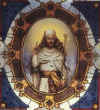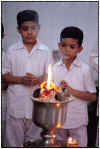|
|
||||
| Home
Feature 'Spirit of India'
Music Music
in Pakistan Health
|
|
|
||
|
the-south-asian.com April 2001 |
||||
|
Page 11 of 11 Parsis - the Zoroastrians of India by Sooni Taraporevala Rituals The navjote, or initiation into the religion, takes place before puberty between the ages of seven and nine for both boys and girls. It is the first time that the child wears the "armour of the religion": the sudrah (shirt), kusti, which should then be worn every day for the rest of his/her life. Zoroastrianism believes that children cannot tell the difference between right and wrong, and therefore cannot sin. Once children freely choose to be initiated, they become adults responsible for their own thoughts, words, deeds, which will determine the fate of their souls on judgment day. The sudrah (shirt), to be worn next to the skin, is made of white cotton, usually thin muslin, (white being a symbol of stainlessness and purity) to remind the wearer that his/her deeds must be as pure and spotless as the sacred shirt they are wearing. The sudrah is made up of two pieces of cloth sewn together on the sides; the two parts, the back and the front symbolic of the past and future, both related to each other through the present. In the front, over the chest is a small pocket (girehban). Called the pocket of righteousness, it is the symbolic collection place for the wearer's good words, good thoughts, good deeds. The kusti, the sacred cord, made of seventy-two threads of lambswool, is entwined thrice around the waist, again symbolically reminding the wearer of the holy triad of good words, thoughts and deeds. The untying and retying of the kusti, accompanied by the kusti prayers, is always done facing the direction of a source of light: the sun, the moon or a lamp. Along with the sudrah, the kusti is the 'badge' of all believers, male or female, rich or poor, priest or layman.
Customs and manners Parsis ritually do not leave the head uncovered and do not smoke. But there are no caste divisions, no religious restrictions about food. Their worship of fire is the highest and purest symbol of the Divinity. The Parsis have remained faithful to their Zoroastrian faith and are proud of their racial purity. Marriage with outsiders is rare. The Parsis worship in fire temples. Fire is of very special significance to the Zoroastrians. It gives light, warmth and energy to the other six creations, and so creates life. The Atash Behram or the Holy Fire is the most important and the most sacred fire. The Prophet saw fire to be the physical representation of Asha (Order/Truth/ Righteousness), and as a source of light, warmth and life for his people. All the religious rituals (the performance of which is an important Zoroastrian duty), are solemnized in the presence of fire, the life-energy. The oldest Atashgah in India at Udwada.There are eight Atash Behrams, or Victorious Fires in India. Four in Mumbai (formerly known as Bombay) in the State of Maharashtra - four in the State of Gujarat, two in Surat, and the remaining in Udwada and Navsari. The Iranshah Atash Behram at Udwada is the oldest [720 AD] – the original fire brought by the fleeing Parsis from Iran and consecrated shortly after their arrival at Sanjan, India. The village of Udwada is hence considered as a centre of pilgrimage by the Parsis and is visited by thousands every year.
They do not cremate or bury the dead and instead leave their dead in Dakhma or the 'Towers of Silence' where they are devoured by vultures. This is done to ensure purity of the elements.
Living a Zoroastrian Life Zarathushtra taught that since this world created by Ahura Mazda is essentially good, man should live well and enjoy its bountiful gifts though always in moderation, as the states of excess and deficiency in Zoroastrianism, are deemed to be the workings of the Hostile Spirit. Man, in Zoroastrianism, is encouraged to lead a good and prosperous life and hence monasticism, celibacy, fasting and the mortification of the body are anathema to the faith; such practices are seen to weaken man and thereby lessen his power to fight evil. The prophet saw pessimism and despair as sins, in fact as yielding to evil. In his teachings, man is encouraged to lead an active, industrious, honest and above all, a happy and charitable life.
The After-Life Doctrine Upon physical death (which is seen as the temporary triumph of evil), the soul will be judged at the Bridge of the Separator, where the soul, it is believed, will receive its reward or punishment, depending upon the life which it has led in this world, based upon the balance of its thoughts, words and deeds. If found righteous, the soul will ascend to the abode of joy and light, whilst if wicked, it will descend into the depths of darkness and gloom. The latter state, however, is a temporary one, as there is no eternal damnation in Zoroastrianism.There is a promise, then, of a series of saviours the Saoshyants, who will appear in the world and complete the triumph of good over evil. Evil will be rendered ineffective and Ahura Mazda, the Infinite One, will finally become truly Omnipotent in Endless Light. There will then take place, a general Last Judgement of all the souls awaiting redemption, followed by the Resurrection of the physical body, which will once again meet its spiritual counterpart, the soul. Time, as we know it, will cease to exist and the seven creations of Ahura Mazda will be gathered together in eternal blessedness in the Kingdom of Mazda, where everything, it is believed, will remain in a perfect state of joy and undyingness. ______________________________
Parsis - The Zoroastrians of India Arrival in India and the beginnings of a new
life The Early Entrepreneurs of Bombay
|
||||
| Copyright © 2000 [the-south-asian.com]. Intellectual Property. All rights reserved. | ||||
| Home |


